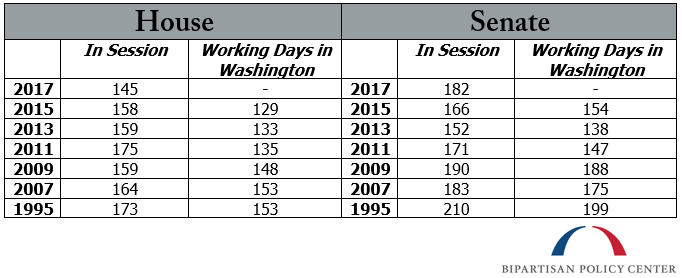New Congress, Same Promises on Working Days
The leadership of the House and Senate this week released calendars of their proposed work schedules for 2017. The Senate plans to be in session for 182 days and the House for 145. The calendars were hailed for increasing the number of days Congress would meet in Washington, and the Bipartisan Policy Center believes additional working days would be a positive development. Still, the calendars should be read with some skepticism. Though the chambers are planning to work more days than the first year of the last Congress, that is already a low bar by historical standards.
Since 2009, the House and Senate have both seen a precipitous drop off in the number of days spent in session. Taking note of this, BPC’s Commission on Political Reform recommends that Congress adopt regular five-day workweeks with every three weeks in Washington followed by one week of state and district work periods. If Congress did this, they would be in Washington for approximately 165 to 185 days a year, when accounting for the traditional August recess. Through our Healthy Congress Index, BPC tracks how often Congress is working in Washington compared with recent years and this recommended target.
In addition to the recent history of fewer days in session, at the beginning of a new Congress leaders often set ambitious goals for the number of days their members will convene in Washington. They typically end up working fewer days than anticipated. For example, in 2015 the Senate planned to be in session for 188 days, but was only in session for 166. Of those days, we count 154 to be working days in Washington.

Simply being “in session” isn’t enough, however. Congress often counts for itself days “in session” where no business is conducted and the chambers meet for minutes or even seconds. These are called “pro forma sessions.” To eliminate these days and provide a more accurate picture of how often Congress is working in Washington, we count only days on which each chamber meets for at least one continuous hour and when there are floor proceedings.
As the index shows, the House and Senate have both seen a decline in the number of true working days regardless of which party controlled the chamber. The House has worked fewer and fewer days since 2007, and the Senate saw a similar decline beginning after 2009. Both chambers have also been significantly below BPC’s recommended five-day work week equivalent.
The House and Senate have both seen a decline in the number of true working days regardless of which party controlled the chamber.
The House’s proposed calendar falls well below our recommendation, and if it is not strictly adhered to or if many of the days are simply pro forma, these gains will not have been truly realized. The House leadership should consider adding days to its calendar, particularly in non-election years such as 2017. BPC is encouraged by the Senate’s 2017 calendar, which is in line with our recommendation, and we urge it to adhere to this schedule without the excessive use of pro forma sessions.
The Healthy Congress Index will continue to closely monitor this metric going forward and hold Congress accountable for their promises to work more days in the 115th Congress.
Share
Read Next
Support Research Like This
With your support, BPC can continue to fund important research like this by combining the best ideas from both parties to promote health, security, and opportunity for all Americans.
Give NowRelated Articles
Join Our Mailing List
BPC drives principled and politically viable policy solutions through the power of rigorous analysis, painstaking negotiation, and aggressive advocacy.